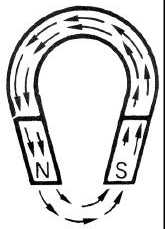T.O. 33B-1-1
3-3
changes in value with changes in the strength of the magnetizing force. A metal that is easy to
magnetize, such as soft iron or low carbon steel, has a high permeability or is said to be highly
permeable.
o. Residual Magnetism. The magnetic field that remains in the parts when the external magnetizing force
has been reduced to zero.
p. Retentivity. The property of a material to remain magnetized after the magnetizing force has been
removed. Metals, such as hard steel with its high percentage of carbon, which retain a strong magnetic
field after removal of the magnetizing current have high retentivity, or are said to be highly retentive.
q. Saturation, Magnetic. The level of magnetism in a ferromagnetic material where the magnetic
permeability is equal to 1. This is characterized as that level where an increasing in magnetizing force
(H) results in no greater increase in magnetic field (B) than would occur in a vacuum or air.
3.1.6
Magnetic Field Characteristics.
3.1.6.1
Horseshoe Magnet.
A familiar type of magnet is the horseshoe magnet as shown in (See Figure 3-1). This is a permanent magnet and
possesses only residual magnetism. It will attract ferromagnetic materials to its ends or poles between which a leakage
field occurs. By convention, these ends are commonly called “north” and “south” poles, indicated by N and S on the
diagram. Continuous magnetic flux lines, or lines of force in leakage fields, flow from the north to the south pole.
These same flux lines continue through the magnet. In an ideal horseshoe magnet, the flux lines leave only at the poles
and consequently an external magnetic force capable of attracting magnetic materials exists only at the poles. This is
an example of a longitudinal magnetic field. In a real horseshoe magnet very small discontinuities are distributed
throughout creating small, weak and very localized leakage fields distributed over the surface of the magnet.
Figure 3-1. Horseshoe Magnet.
3.1.6.1.1
If the shape of an ideal horseshoe magnet is changed as shown in Figure 3-2, the ends will still attract other magnetic
materials. However, if the ends of the magnet are fused or welded into a continuous ring as shown in Figure 3-3, the
magnet will no longer attract or hold exterior magnetic materials. This is because the north and south poles no longer
exist; thus a large leakage field does not exist. The magnetic field will remain as shown by the arrows, but there is no
attraction for external ferromagnetic materials. This is an excellent example of a circular magnetic field. The change
in magnetic field from longitudinal to circular by fusing the ends of the magnet is caused by the elimination of the large
north and south poles present in the horseshoe magnet.

